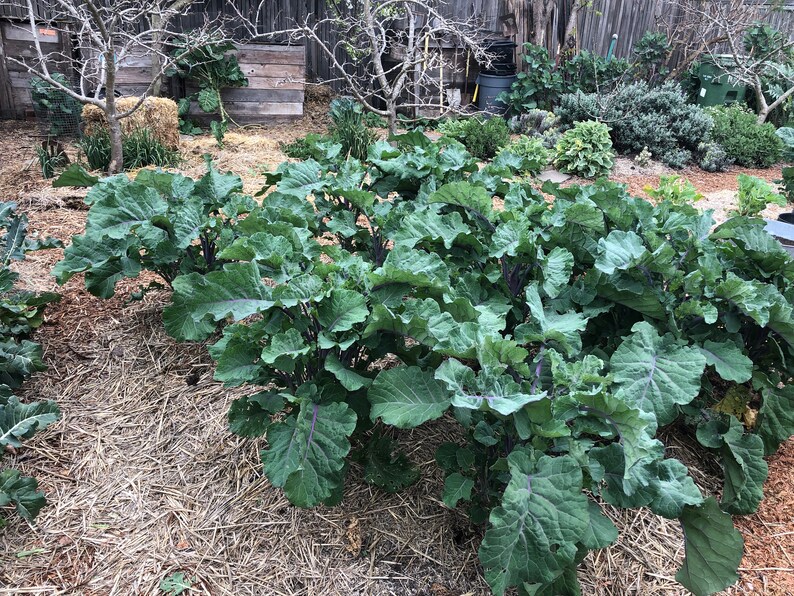
As we have a fairly long growing season, I am hopeful that we can grow them quite tall, and experiment with many potential uses for them.
#Buy purple tree collards full
The stalks were also used as fence posts and as building rafters, so they were stout indeed, though they needed to be hung to cure for a full year before being put into use for such purposes.

In fact, one of my biggest reasons for wanting to grow it is for the stout stalks, which for generations were indeed fashioned into walking sticks which were available only in the Channel Islands, and evidently highly sought after in their day.Īs an organic gardener, I will clearly be ignoring the recommendations for using chemical fertilizers and pesticides, in favor of more earth-friendly methods. Naturally, in the coldest climates, the growing season won't be long enough for it to reach the towering heights that it can reach in the Channel Islands where it is native, where it can reach as much as 18' to 20', or over six meters in height. This interests me a great deal, since I'd ultimately like to have sheep for wool and a milk cow or two, and having a high quality and extremely productive fodder source for them would be extremely important, and save us a great deal versus feeding purchased hay.įurther, according to an article in SF Gate, walking stick cabbage grows in hardiness zones 2 through 11, meaning virtually anywhere in the U.S., as well as most of the world. In fact, according to Wikipedia, "The Farmer's Magazine stated in 1836 that five plants would support 100 sheep or 10 cows, and sheep fed them were rumoured to produce silky wool up to 25 inches (64 cm) in length." That's a lot of cabbage! Like tree collards, walking stick cabbage produces a large amount of edible greens, that can be used as food for humans and/or as fodder for animals. I'm also hoping to start walking stick cabbage this coming year, aka Jersey cabbage, but the seeds have yet to arrive, even though I ordered them far earlier than the purple tree collards.


My plan is to start some along the south wall of the main house, which should give them some mitigation against the cold some against the south wall of the studio, which should be a few degrees warmer and better protected from the wind, as it is in a hollow and protected by trees on all sides and some out in the open, hopefully by then with adequate fencing to protect against the deer.īy trying them out in several microclimates, of which we have many on our place, I should get a much better idea of their actual benefits and limitations, how they perform in different conditions, and whether they can indeed be perennial in our climate. I've read conflicting information about purple tree collards, with some sources saying they'll survive in Zone 6b, which was the zone when we first moved here some claiming Zone 7a, which is the zone we're now in since the USDA revised them a couple of years back and no one seeming to have really definitive answers. The six extra cuttings, once safely ensconced in their pots, to root over the winter with the others. These are the twelve cuttings I ordered, once safely ensconced in their pots, to root over the winter.Īnd bonus! The seller included six extra cuttings for us, which jazzes me more than I can say, as I've been wanting to grow these for years now! The cuttings once unwrapped and ready for planting. And they arrived healthy and looking great! This is more or or less how they arrived, wrapped in damp paper, wrapped in more paper, and finally wrapped in a ziploc bag rubber banded to hold in the moisture. If you’d like to learn more about another amazing experimental perennial kale project, check out the work the Experimental Farm Network is doing.I'm jazzed that I already received the cuttings of purple tree collards that I ordered a mere three days earlier, so I spent some time Sunday evening planting them. Thanks goes to Graham Jenkins-Belohorska and the kale crossing work he’s done in the UK and where the genetics and seeds originated for this wonderful kale! If you have these critters in your garden there is a little maintenance to keep the leaves from turning in to lace!

Very vigorous grower, great for livestock forage or some years could be used as a chop and drop mulch (we can only eat so much kale!)Ĭhallenges: Like all kale and broccoli family plants, this kale is loved by cabbage eating caterpillars. Uses: Very nutritious cooked vegetable, more tender then traditional collard greens. Grows best in rich garden soil, can take some drought but prefers ample water for good leaf production Scientific name: Brassica oleracea ramosa, seedling of a cross of ‘Purple Tree Collards’ and ‘Daubenton’


 0 kommentar(er)
0 kommentar(er)
